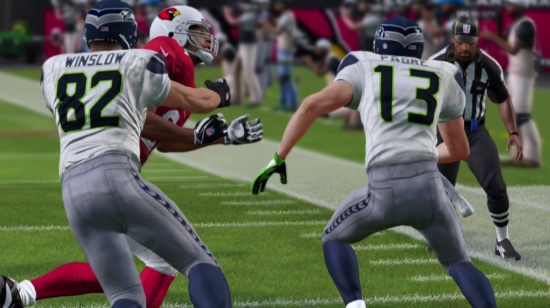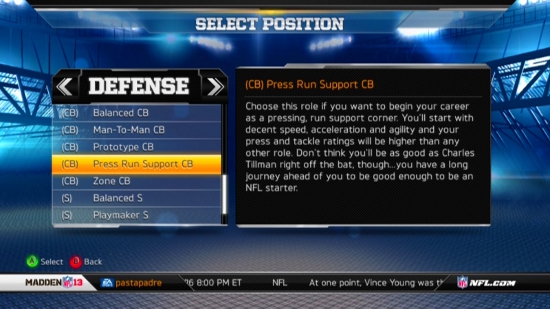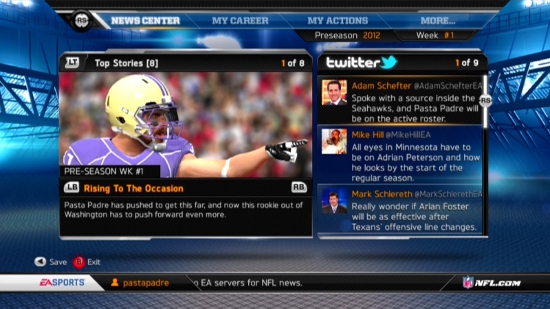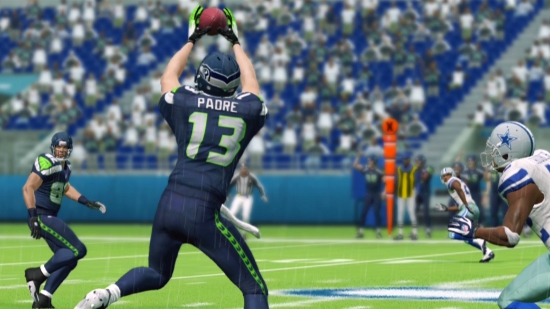Madden NFL 13 Complete Player Connected Career Impressions

Going through Madden NFL 13’s Connected Careers mode as a “Coach” may be intimidating to some – but in doing so as a “Player” it will not be nearly as overwhelming. The trade-off then comes in what is a somewhat less engaging experience. A career can be progressed through in much quicker fashion by skipping a good portion of games and not having to micromanage the weekly tasks that befall a “Coach” while the emphasis on XP to improve attributes and skills adds some investment to the player’s development.
Beginning a career as a “Player” again offers the opportunity to create someone new either from scratch or using the “Game Face” feature, take over a current player in the league, or use one of the legends being offered. This comes after deciding whether to do an “Offline” or “Online” career. There are several advantages to being online, even if playing solo, but it does require a constant connection to the EA Servers.
If a created player is chosen the process to craft their skills and appearance heading into the league arises. The first thing to choose is the position and type of player. That will end up determining effectiveness within a team’s system (based on fit) while also shaping initial skills. Then comes picking from three backstories: High Draft, Low Draft, and Undrafted. The path chosen will play into ratings levels, probably overalls of low-80s to mid-70s to upper 60s, as well as expectations and ability to earn XP.
At one point created players were being made the starter at every position regardless of ratings. That since has been fixed so those players will be down on the depth chart and have to work towards increasing ratings (primarily or solely through practices) for a chance at more playing time and an eventual role as a starter.

Game Face again deserves praise for how well the feature works now. As mentioned though in the “Coach” impressions my Game Face broke everything in which it was attempted to be used within Madden 13. Based on discussion elsewhere this seems to have been an isolated issue as others are using theirs just fine. It’s pretty cool to see what truly really looks like you, or whoever was created, up on screen.
Online leagues can include up to 32 users – each one controlling either a team as a “Coach” or a single “Player”. The career settings allows the commish to decide on whether only Coaches, only Players, or both are allowed in a league. Legends can be allowed or excluded as well.
The rate at which XP is earned is even more critical as a Player. Unfortunately, as usual, the positions that can generate consistent stats are the ones who have the best ability to progress. XP can be generated by contributing to team goals but in the end it’s the personal goals and making plays that show up in the stats column that matter the most. That means positions like QB, RB, and WR will have a distinct advantage over any position on defense. Safety can be fun (thanks to the “Ball Hawk” feature in particular) but otherwise it’s a slog through practices and the season where contributions aren’t always recognized.
In a run through as an outside linebacker, as a late round draftee, my player was buried on the depth chart. That meant the only opportunity to earn XP and begin to raise the ratings to a point where the player would get some time on the field came solely through practice. Sadly barely 1200 in XP was earned over the course of 17 regular season practices. After spending that (could buy a single trait with that which wasn’t even enough to up speed a single point) the player went from a 76 overall at the start of the season to a 76 overall at the end. Progressing players who can’t put up big numbers solely through practice appears extremely difficult if not impossible.
Practices are largely predicated on winning a certain scenario in which a certain XP will be awarded – plus there is the opportunity to gain individual XP based on performance within the practices. Again this will favor skill positions. While I like being in a spot where practices are actually valuable and necessary – simming them doesn’t result in any XP – there has to be a better way to earn the XP in other positions. Losing a scenario means being awarded only a fraction of XP (100-250) and that makes those attempts basically complete wastes of time. There should be more reward for the actual process of a practice rather than just being centered on winning when on the “Player” side of Connected Careers.
The games are played from the standard camera angle rather than a position-specific one. Some will like that – it’s certainly a more comfortable way to play – but it also means receivers and corners are sometimes off-screen making those positions tougher to handle. The side of the ball not being played on is displayed through SuperSim. Even though only the one player is handled on the field there is complete control over team actions.
Play-calling and adjustments are handled for the entire team rather than just the single player in question. Even the snap when playing on offense at a position other than QB is made by the user – as is the actual kick or punt when on the field as a special teamer – and for some reason the user gets stuck watching punts and kicks when an offensive player in a spectator type view.
QBs will always have the ball in their hands while the user can even force CPU-controlled QBs to pass the ball their way. Controlling the play calling completely means less frustration out of the CPU making those calls but also leaves it in the hands of the user to slant the action their way. As a QB, WR, or TE they can pass the ball every down and as a RB can run the ball more than typical. As a receiver in one game on All-Pro I found it very easy to rack up the stats and in turn earned over half of the XP that my outside linebacker made the entire season in practices with just that single game.
Once in a game there is no “Sim to End” or even “Quit Game” option. You’re stuck in the game through its entirety unless you want to turn the console off completely. Both options really need to be added next year. There is also no way to go back and watch a replay once the game hits that SuperSim screen or create a highlight and that includes after the game is over. Having the ability to tweet or post to Facebook the results remains a nice new option.

The presentation in-game is again lacking and that damages the ties to the rest of the league that the player resides in. There are no graphics to inform of season stats, team standings, results around the league, or developments around the career of that player. The same goes for the commentary team of Jim Nantz and Phil Simms who call the games the exact same as they would a “Coach” game. There are no special references to the player in question. While the news hub within the menus is fantastic – and the Twitter mentions are especially awesome – all ties to the league are lost when a game is actually started up.
Commentary also struggles because the flow of the game is completely disregarded when going through them as “Players”. There are so many stops to the action as a transition is made to the SuperSim for example – that Nantz and Simms rarely can make it through a story or line without being cut off.
Players can request a release from the team with the hopes that another will snag them off free agency. That isn’t guaranteed to happen though in which case a player would then be forced to retire. One missing element is the ability to request a trade. It is surprising that one didn’t make it in since the player could then have just been added to a “Trade Block” which seems to generate offers immediately on the “Coach” side of things.
In a real head-scratcher of a design decision Kinect for Xbox 360 functionality is not available within Connected Careers as a “Player”. This is really disappointing – not just because it would make sense to make voice calls for an individual player, but everything else about the games are essentially the same (pre-snap adjustments, play calling, controlling timeouts) with the exception of supersimming when not on the field.
There are several “love it or hate it” elements of Connected Careers as a “Player”. Those include having control over the decision making for the entire team on that side of the ball, being able to direct the action towards the player being controlled when on offense, and utilizing the standard camera angle regardless of position. There is an odd sense of imbalance when it comes to realism with players having to work their way up as they should but those who get on the field as an offensive player being easily able to pad stats and increase XP. The mode is also not always very user-friendly particularly within games which can’t be simmed ahead or exited early.

There is no question that being a “Player” in Connected Careers is a far more compelling and rich experience than Superstar mode of old. Offensive positions are really fun – in part because they can remain involved in the action as much as desired – while defensive positions (and those in particular that don’t rely on stats as the primary measure of success) find themselves at a big disadvantage. In the future there needs to be more ties to the league and player developments through presentation to build that emotional investment in their development and place within the NFL. Despite possessing several areas with substantial room for improvement tying all the features of Connected Careers together and then being able to branch out as either a “Coach” or “Player” has proven to be an exceptionally beneficial idea.
